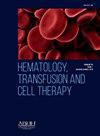CASES OF PRIMARY CUTANEOUS ANAPLASTIC LARGE CELL LYMPHOMA TREATED WITH SYSTEMIC OR LOCAL THERAPY
IF 1.6
Q3 HEMATOLOGY
引用次数: 0
Abstract
Introduction
Primary Cutaneous Anaplastic Large Cell Lymphoma (PC-ALCL) is a CD30+ peripheral T-cell lymphoproliferative disorder without systemic involvement. It accounts for approximately 8% of cutaneous lymphoma cases. Most patients with PC-ALCL present with slow-growing, solitary or grouped skin nodules, and in some cases, regional lymph node involvement is observed.
Case-1
A 61-year-old male patient presented to our clinic with swelling and edema of the right lower lip, along with a 57 cm draining ulcerative skin lesion in the suprasternal region. The patient had previously received six cycles of treatment for T-cell lymphoma at an outside center. A PET-CT scan identified a soft tissue lesion in the skin/subcutaneous tissue at the level of the right thyroid lobe and isthmus, measuring 57*15*52 mm, with a maximum SUV of 34. Biopsies taken from the lower lip and suprasternal skin were reported as primary cutaneous anaplastic large cell lymphoma. CD30 expression was found to be 95%. The patient was started on brentuximab vedotin along with the GDP protocol. After two cycles of treatment, improvement in the skin lesions was observed.
Case-2
A 61-year-old male patient presented to our clinic with a complaint of a lesion on the anterior surface of the right tibia, measuring approximately 10*10 cm. The biopsy taken from the lesion was reported as CD30+ primary cutaneous anaplastic large cell lymphoma. A PET-CT scan revealed moderately hypermetabolic lymph nodes with thick cortices in the right iliac and inguinal lymphatic chains. Radiotherapy was applied to the area of the primary lesion and the regional lymph nodes, and improvement in the skin lesions was observed with treatment.
Discussion
We aimed to discuss the outcomes of applying localized radiotherapy or systemic treatment to two patients with PC-ALCL who presented to our clinic: one with a relapse and the other with a new diagnosis. Brentuximab vedotin is effective in this disease. Since disease control could not be fully achieved with localized radiotherapy alone, we believe that the combination of systemic therapy and radiotherapy may be an important treatment option for these patients. Further large-scale case series are needed to guide treatment.
原发性皮肤间变性大细胞淋巴瘤的全身或局部治疗
原发性皮肤间变性大细胞淋巴瘤(PC-ALCL)是一种CD30+外周t细胞增生性疾病,无全身累及。它约占皮肤淋巴瘤病例的8%。大多数PC-ALCL患者表现为生长缓慢、孤立或成组的皮肤结节,在某些情况下,观察到局部淋巴结受累。病例- 1a患者,61岁男性,右下唇肿胀水肿,胸骨上区出现57 cm引流性溃疡性皮肤病变。该患者此前在外部中心接受了6个周期的t细胞淋巴瘤治疗。PET-CT扫描发现右甲状腺叶峡部皮肤/皮下软组织病变,尺寸为57*15*52 mm,最大SUV为34。下唇及胸骨上皮肤活检报告为原发性皮肤间变性大细胞淋巴瘤。CD30表达率为95%。患者开始使用brentuximab vedotin和GDP方案。两个治疗周期后,观察到皮肤病变的改善。病例- 2a, 61岁男性患者,因右胫骨前表面病变,面积约10* 10cm而就诊。病变活检报告为CD30+原发性皮肤间变性大细胞淋巴瘤。PET-CT扫描显示中度高代谢淋巴结,右髂和腹股沟淋巴链皮质厚。对原发病灶及局部淋巴结进行放疗,观察皮肤病灶的改善情况。我们的目的是讨论两例PC-ALCL患者应用局部放疗或全身治疗的结果,他们来到我们的诊所:一个复发,另一个新诊断。Brentuximab vedotin对这种疾病有效。由于局部放疗不能完全控制疾病,我们认为全身治疗和放疗相结合可能是这些患者的重要治疗选择。需要进一步的大规模病例系列来指导治疗。
本文章由计算机程序翻译,如有差异,请以英文原文为准。
求助全文
约1分钟内获得全文
求助全文
来源期刊

Hematology, Transfusion and Cell Therapy
Multiple-
CiteScore
2.40
自引率
4.80%
发文量
1419
审稿时长
30 weeks
 求助内容:
求助内容: 应助结果提醒方式:
应助结果提醒方式:


